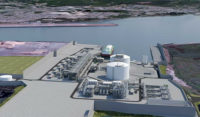ExxonMobil's restructuring has put its clean energy operation on equal footing with its traditional oil and gas, refinig and petrochemical operations, the company said in announcing the corporate shift on Jan. 31.
The units—renamed Upstream Company, which includes oil and gas exploration; Product Solutions, refining and petrochemicals manufacture; and the elevated Low Carbon Solutions—will be supported by a single technology organization, ExxonMobil Technology and Engineering.
The changes, which take effect April 1, will better position the Houston energy giant in changing markets, it said.
Exxon Mobil can play a significant role in the energy transition given the growth potential for lower-emission fuels, carbon capture and hydrogen, Darren Woods, chairman and CEO said Feb. 1 during the company’s fourth-quarter results call with analysts.
Even so, firm revenue rose more than 80% for the quarter year over year to nearly $85 billion on rising oil and gas prices, with $8.9 billion in earnings reversing a $20 billion loss in the same period in 2020. Exxon Mobil said it is on track to cut $6 billion in operating costs by next year from their level in 2019.
In May 2021, investors conveyed a message that climate change urgency will require strategic changes in company operations. They voted to accept three new board directors in a strategy pushed by a small activist investor but opposed at the time by Woods.
“Utilizing our existing capabilities and skills—developed over decades—we can capture the lower-emission business opportunities at an industry-advantaged cost. Today, we are doing work to demonstrate this through our Low Carbon Solutions business and the more than $15 billion of investments to accelerate accretive lower-emissions opportunities,” Woods said.
Under a rapid transition, the company would reduce investments in oil and gas and increase spending on lower emission business opportunities and chemicals, but it also has flexibility to shift resources between its traditional business and low-carbon business at any rate to adjust to the energy transition, Woods said.
The new ExxonMobil Product Solutions unit will engineer, manufacture and deliver products that will play a critical role in reducing greenhouse gas emissions as well as plastic waste. Other products will lower emissions in agriculture, health and renewable energy sectors, the company said.
The Low Carbon Solutions business is focused on GHG cuts in hard-to-decarbonize sectors—including heavy industry, commercial transportation and power generation. “And that’s a global business with opportunities that we see developing all around the planet and many, many countries and there’s policy in place today to support those investments,” Woods told analysts.
ExxonMobil has received interest from 11 companies to support large-scale carbon capture and storage hubs, with the first near Houston. “We believe that by 2040, it could be possible to annually capture about 100 million metric tons of CO2 from refineries, chemical plants and power generation facilities in the area,” Woods said in November.
Other hubs are in development with European countries, with more under consideration or development in Canada, Malaysia, Indonesia, Australia, Russia and Qatar. On the firm's longer-term radar are hubs in Russia and Australia.
“In Wyoming, we’re planning to expand carbon capture and storage capacity at our natural gas and helium production site, which has already captured more CO2 than any other facility in the world," Woods said.
Other emission reduction developments include an agreement with Scepter Inc. to deploy advanced satellite technology and proprietary data processing platforms to detect methane emissions globally. It will focus on the Permian Basin in Texas initially but has potential to redefine methane detection and mitigation efforts and could contribute to broader satellite-based emission-reduction across a dozen global industries, including energy, agriculture, manufacturing and transportation, the company said.
In January, ExxonMobil said it plans to achieve net-zero emissions from operations by 2050, with emission reduction roadmaps to be developed for each individual operation.
But some market observers and analysts said the emissions-cutting plan needs to be more robust.
It's a portion of a portion of a plan," Andrew Logan, senior director for oil and gas at Ceres, an investor activist nonprofit focused on sustainability and environmental issues, told S&P Global.




